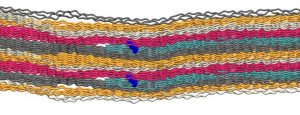Build your collagen fibril!

Obtain your atomistic collagen fibril models with ColBuilder! We have now published a web resource of collagen models for 20 different species with a large variety of crosslink types and localization within the fibril, to facilitate structure-based analyses and simulations of type I collagen in health and disease. To easily enable simulations, we provide parameters of the modeled crosslinks for an AMBER force field. This resource developed at HITS has now been published in „Biophysical Journal“. The repository of collagen models is available at https://colbuilder.h-its.org.
Type I collagen is the main structural component of many tissues in the human body. It provides excellent mechanical properties to connective tissue and acts as a protein interaction hub. There is thus a wide interest in understanding the properties and diverse functions of type I collagen at the molecular level. A precondition is an atomistic collagen I structure as it occurs in native tissue. To this end, we built full-atom models of crosslinked collagen fibrils by integrating the low-resolution structure of collagen fibril available from X-ray fiber diffraction with high-resolution structures of short collagen-like peptides from X-ray crystallography and mass spectrometry data.
The obtained models are made available through an interactive web server, which allows to choose between 20 different species, 8 different crosslink types and crosslink composition (individual choices among crosslink types at different collagen sites within the same model). On the one hand, users can download PDB-files containing models of the complete 300 nm single triple helix, which include the symmetry record allowing for the generation of collagen fibril bundles of any size. On the other hand, we also provide models of predefined bundles of collagen fibril fragments, comprising 41 triple helices, spanning one central overlap and one gap region (the latter in two parts) as shown in the Figure below. These models of fibril bundles are ready to use in MD simulations e.g. using GROMACS. To this end, a tar archive with a complete modified Amber99SB*-ildnp force field can be downloaded. Additionally, this archive contains a directory with only the additional crosslink parameters, which in turn can then be integrated into any Amber99 force field as well.
The repository of collagen models is available at https://colbuilder.h-its.org.

Atomistic model of a Collagen type 1 fibril fragment as obtained from ColBuilder. It comprises 41 triple helices spanning one central overlap and one gap region (in two parts, left and right). Triple helices are colored according to the staggering distance, crosslinks are shown in blue.
Article in Biophysical Journal (download here):
ColBuilder: a server to build collagen fibril models
Agnieszka Obarska-Kosinska, Benedikt Rennekamp, Aysecan Ünal and Frauke Gräter
Biophysical Journal
DOI: https://doi.org/10.1016/j.bpj.2021.07.009
Scientific Contact:
Prof. Dr. Frauke Gräter
Group Leader „Molecular Biomechanics“
HITS – Heidelberg Institute for Theoretical Studies
E-mail: frauke.graeter@h-its.org
About HITS
HITS, the Heidelberg Institute for Theoretical Studies, was established in 2010 by physicist and SAP co-founder Klaus Tschira (1940-2015) and the Klaus Tschira Foundation as a private, non-profit research institute. HITS conducts basic research in the natural, mathematical, and computer sciences. Major research directions include complex simulations across scales, making sense of data, and enabling science via computational research. Application areas range from molecular biology to astrophysics. An essential characteristic of the Institute is interdisciplinarity, implemented in numerous cross-group and cross-disciplinary projects. The base funding of HITS is provided by the Klaus Tschira Foundation.